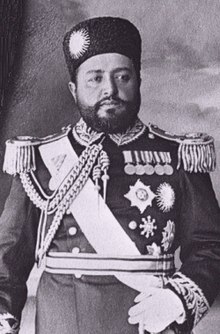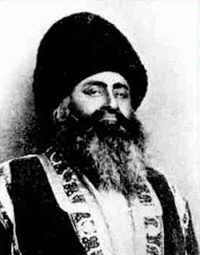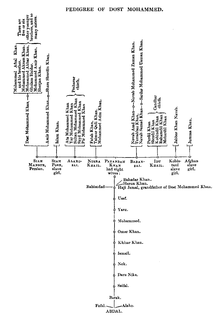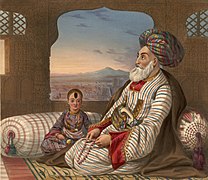Barakzai dynasty
| Barakzai بارکزایی | |
|---|---|
(1823–1855) (Emirate of Kabul) (1855–1926) (Emirate of Afghanistan)
(1973–1978) | |
| Founded | 1823 |
| Founder |
|
| Current head |
|
| Final ruler |
|
| Titles | King of Afghanistan President of Afghanistan Sardar (Prince) of Afghanistan Father of the Nation Head of the House of Barakzai Ruler of Kandahar |
| Estate(s) | Afghanistan, Khyber Pashtunkhwa and Balochistan |
| Deposition | 1978 (Saur Revolution) |
The Barakzai dynasty (
Prior the seizing of the Durrani empire by the Barakzai dynasty,
History and background
| History of Afghanistan | |
|---|---|
 | |
| Timeline | |
| 410–557 | |
| Nezak Huns | 484–711 |
Ancestrial background
The Barakzai claim descent from
Qais Abdur Rashid's descendant Sulaiman, also known as "Zirak Khan" is regarded as the forefather of the Durrani Pashtuns to whom the Barakzai also belonged, next to the Popalzai and Alakozai. It is through Sulaiman's son Barak, that the Barakzai derive their name from, because Barakzai means "children of Barak".[15]
Naming Afghanistan
It was in honor of their ancestor Prince Afghana of Israel, whom some Muslims venerate as a Saint that
Political background
The Barakzai dynasty was the line of rulers in Afghanistan in the 19th and 20th centuries. Following the fall of the
Definition and Cadet Branches
The Royal Barakzai or "Muhammadzai" are the descendants of the founder of the Barakzai dynasty the Emir ul Umara (Emir of all Emirs) Payindah Mohammed Khan, who plotted against the Durrani Imperial Family, proclaimimg himself Emir. Upon all descendants of Emir Payindah Mohammed the hereditary title Sardar (Prince) is bestowed.[18]
Seraj

The Seraj cadet-branch are the descendants of Emir
Telai

The Telai cadet-branch are the descendants of
Another Telai branch that had immense power in Afghanistan's military was that of His Royal Highness Field Marshal Prince Abdul Aziz Khan Telai and his children. Prince Abdul Aziz Telai was son of
Another known son of Prince Abdul Aziz was HRH Field Marshal Prince Amir Muhammad Khan Telai, who proclaimed himself Shah in exile in Peshawar contesting the rule of his rival cousin Mohammad Nadir Shah, siding with the British. His son Assadullah, whose nickname was "Sharza" became a General in the US Air Force, representing Telai interests in Washington DC.[21][22]
Another well known son of Prince Abdul Aziz was Brigade General Sardar Abdul Ghafar Khan, who acted as Commander of the Personal Royal Brigade of his cousin
Shaghasi

The Shaghasi cadet-branch is another prominent and powerful sub-tribe of Barakzai, descending from the brothers of Emir Sultan Mohammed Khan and Emir Dost Mohammed Khan.[23]
Shaghasi Khel are descendants of Mirdaad Khan Barakzai, Işik Aqasi (Minister of the Royal Court "Chemberlain") during the reign of the Kandahari Sardars (
Ali Ahmad Khan Shaghasi (1883–1929) who was declared Emir of Afghanistan twice in 1929 son of General H.E. Loinab Khushdil Khan, sometime Governor of Kabul and Kandahar, by his wife Sahira Begum, daughter of H.H. Amir al-Mumenin, Amir al-Kabir, Amir Dost Muhammad Khan, Amir of Afghanistan, by his wife, a daughter of Agha Muhammad Qizilbash was also Shaghasi Barakzai. Ali Ahmad's sister, the Ulya Mukhadara Zarin Jan Begum was the mother of Humaira Begum who was the Queen consort of Afghanistan.[28]
List of Barakzai rulers
| Name | Lifespan | Reign start | Reign end | Notes | Family | Image |
|---|---|---|---|---|---|---|
| Sardar Sher Dil Khan | 1818 | July 1828 | Sardar Sher Dil Khan son of Sardar Payendah Khan, grand son of Sardar Jamal Khan Barakzai. Shaghasi Mirdaad Khan Barakzai' son of Bazar Khan Barakzai, grand son of Sardar Yasin Khan Barakzai, as his Işik Aqasi (Minister of the Royal Court "Chemberlain"). | Barakzai | ||
| Sardar Pur Dil Khan | 1828 | 1830 | Sardar Pur Dil Khan' son of Sardar Payendah Khan, grand son of Sardar Jamal Khan Barakzai. Bamiyan and military regent of Kashmir . Was buried at the shrine of Hz. Ge Baba in Qandahar, used as mausoleum for the Qandahari Kings.Shaghasi Mirdaad Khan Barakzai' son of Bazar Khan Barakzai, grand son of Sardar Yasin Khan Barakzai, as his Işik Aqasi (Minister of the Royal Court "Chemberlain"). | Barakzai |  | |
| Sardar Muhammad Sadiq Khan | 1855 | 1855 | Son of Sardar Kohan Dil Khan, grand son of Sardar Payendah Khan Barakzai. was in 1838 regent of Farah | Barakzai | ||
| Dost Mohammad Khan | 1855 | Unified the principality of Qandahar with the Emirate of Kabul to Emirate of Afghanistan. | Barakzai |
Emirate of Afghanistan
(Emirate of Kabul 1823–1855)
| Name | Lifespan | Reign start | Reign end | Notes | Family | Image |
|---|---|---|---|---|---|---|
Sultan Mohammad Khan
| 1792–1834 | 1823 | 1826 (resigned) | Regent of Kabul and of Peshawar; Son of Sardar Payendah Khan, brother of Dost Mohammad Khan | Barakzai |  |
| Dost Mohammad Khan (1st reign)
| 23 December 1792 – 9 June 1863 | Summer 1826 | 6 August 1839 (deposed) | Shaghasi Mirdaad Khan Barakzai' son of Bazar Khan Barakzai, grand son of Sardar Yasin Khan Barakzai, as his Işik Aqasi (Minister of the Royal Court "Chemberlain"). Son of Sardar Payendah Khan, grand son of Sardar Jamal Khan Barakzai Forged campaigns to re-unite Afghanistan which was divided due to the civil wars between the sons of Timur Shah Durrani. Reign disputed from 1839 to 1842 by Shah Shuja Durrani in the First Anglo-Afghan War | Barakzai |  |
Akbar Khan
| 1816–1847 | May 1842 | 1843 | Shaghasi Shir Mohammad Khan' son of Shaghasi Mirdaad Khan Barakzai, grand son of Bazar Khan Barakzai, as his Işik Aqasi (Minister of the Royal Court "Chemberlain"). Son of Dost Mohammad Khan, grand son of Sardar Payendah Khan Barakzai | Barakzai |  |
| Dost Mohammad Khan (2nd reign)
| 23 December 1792 – 9 June 1863 | 1843 | 9 June 1863 | Shaghasi Mirdaad Khan Barakzai' son of Bazar Khan Barakzai, grand son of Sardar Yasin Khan Barakzai, as his Işik Aqasi (Minister of the Royal Court "Chemberlain"). Son of Sardar Payendah Khan, grand son of Sardar Jamal Khan Barakzai Loynab Shir Dil Khan Shaghasi' son of Shaghasi Mirdaad Khan Barakzai, grand son of Bazar Khan Barakzai, as his Işik Aqasi (Minister of the Royal Court "Chemberlain") 1856. Returned to the throne after the British and Shah Shuja were defeated in the First Anglo-Afghan War. Coined the term "Afghanistan" after an alliance with the British. Went on to defeat the remaining powers inside Afghanistan[30], reunifying the country after a brutal civil war lasting 70 years from 1793 to 1863 by the time of his death | Barakzai |  |
| Sher Ali Khan (1st reign) | 1825 – 21 February 1879 | 9 June 1863 | May 1866 (deposed) | Loynab Shir Dil Khan Shaghasi' son of Shaghasi Mirdaad Khan Barakzai, grand son of Bazar Khan Barakzai, as his Işik Aqasi (Minister of the Royal Court "Chemberlain"). Son of Dost Mohammad Khan, grad son of Sardar Payendah Khan | Barakzai |  |
| Mohammad Afzal Khan | 1815 – 7 October 1867 | May 1866 | 7 October 1867 | Son of Dost Mohammad Khan | Barakzai |  |
| Mohammad Azam Khan | 1820–1870 | 7 October 1867 | 21 August 1868 | Son of Dost Mohammad Khan | Barakzai |  |
| Sher Ali Khan (2nd reign) | 1825 – 21 February 1879 | 9 September 1868 | 21 February 1879 | Loynab Shir Dil Khan Shaghasi' son of Shaghasi Mirdaad Khan Barakzai, grand son of Bazar Khan Barakzai, as his Işik Aqasi (Minister of the Royal Court "Chemberlain"). Son of Dost Mohammad Khan, grand son of Sardar Payendah Khan. Mohammad Yusof Khan Shaghasi' son of Loynab Shir Dil Khan Shaghasi, grand son of Shaghasi, as his Işik Aqasi (Minister of the Royal Court "Chemberlain"). 1874 | Barakzai |  |
| Mohammad Yaqub Khan | 1849 – 15 November 1923 | 21 February 1879 | 12 October 1879 (deposed) | Sardar Attaullah Khan Shaghasi' son of Shaghasi Mirdaad Khan Barakzai, grand son of Bazar Khan Barakzai, as his Işik Aqasi (Minister of the Royal Court "Chemberlain"). Son of Sher Ali Khan, grand son of Dost Mohammad Khan Deposed during the Second Anglo-Afghan War | Barakzai |  |
Ayub Khan
| 1857 – 7 April 1914 | 12 October 1879 | 31 May 1880 (deposed) | Ghazi Khoshdil Khan Shaghasi' son of Loynab Shir Dil Khan Shaghasi, grand son of Shaghasi Mirdaad Khan Barakzai, as his Işik Aqasi (Minister of the Royal Court "Chemberlain"), and the second commander in the Battle of Maiwand. Later Kamkainaab, Loynaad, Governor of Kabul, Balkh and Kandahar during the reigns of Sher Ali Khan, Habibullah Khan, and Amanullah Khan. Son of Sher Ali Khan, grand son Dost Mohammad Khan. Defeated in the Battle of Kandahar against Abdur Rahman Khan and exiled at the end of the Second Anglo-Afghan War | Barakzai |  |
Abdur Rahman Khan
| 1840/44 – 1 October 1901 | 31 May 1880 | 1 October 1901 | Sardar Mohammad Sarwar Khan Shaghasi (Baba)' son of Sardar Attaullah Khan Shaghasi, gran son of Shaghasi Mirdaad Khan Barakzai, as his Işik Aqasi (Minister of the Royal Court "Chemberlain"). Son of Mohammad Afzal Khan, grand son of Dost Mohammad Khan | Barakzai |  |
| Habibullah Khan | 3 June 1872 – 20 February 1919 | 1 October 1901 | 20 February 1919 | Mohammad Shah Khan Shaghasi' son of Sardar Amir Mohammad Shaghasi, gran son of Shaghasi Mirdaad Khan Barakzai, as his Işik Aqasi (Minister of the Royal Court "Chemberlain") when Habibullah Khan was still a Crown prince. Nazim Dost Mohammad Khan Shaghasi' son of Sardar Amir Mohammad Shaghasi, gran son of Shaghasi Mirdaad Khan Barakzai, as his Işik Aqasi (Minister of the Royal Court "Chemberlain"). Later Nazim (Leading Commander of Central Afghanistan), Nayabsalar (Lieutenant General), Sepahsalaar (General), the first Dar-ul-Adalat (Minister of Justice), Hakim-e-Ala (Great Governor) of Ghazni, Uruzgan and Kandahar during the reigns of Abdur Rahman Khan, Habibullah Khan, and Amanullah Khan. Son of Abdur Rahman Khan, grand son of Mohammad Afzal Khan | Barakzai |  |
| Nasrullah Khan | 1874–1920 | 20 February 1919 | 28 February 1919 (deposed) | Khwaja Mohammad Khan Shaghasi' son of Sardar Amir Mohammad Shaghasi, gran son of Shaghasi Mirdaad Khan Barakzai, as his Işik Aqasi (Minister of the Royal Court "Chemberlain") when Nasrullah Khan was Hakim (Governor) of Qalaat. Nazim Dost Mohammad Khan Shaghasi' son of Sardar Amir Mohammad Shaghasi, gran son of Shaghasi Mirdaad Khan Barakzai, as his Işik Aqasi (Minister of the Royal Court "Chemberlain"). Later Nazim (Leading Commander of Central Afghanistan), Nayabsalar (Lieutenant General), Sepahsalaar (General), the first Dar-ul-Adalat (Minister of Justice), Hakim-e-Ala (Great Governor) of Ghazni, Uruzgan and Kandahar during the reigns of Abdur Rahman Khan, Habibullah Khan, and Amanullah Khan. Son of Abdur Rahman Khan, grand son of Mohammad Afzal Khan | Barakzai |  |
| Amanullah Khan | 1 June 1892 – 25 April 1960 | 28 February 1919 | 9 June 1926 | Yawar Mahmoud Khan Shaghasi' son of Mohammad Shah Khan Shaghasi, grand son of Sardar Amir Mohammad Shaghasi, as his Işik Aqasi (Minister of the Royal Court "Chemberlain"). Later the first Yawar Awal (Vice president), and Governor of Kabul during the reign of Amanullah Khan. Son of Habibullah Khan, grand son of Abdur Rahman Khan | Barakzai |  |
Kingdom of Afghanistan (1926–1929)
| Name | Lifespan | Reign start | Reign end | Notes | Family | Image |
|---|---|---|---|---|---|---|
| Amanullah Khan | 1 June 1892 – 25 April 1960 | 9 June 1926 | 14 January 1929 (abdicated) | Yawar Mahmoud Khan Shaghasi' son of Mohammad Shah Khan Shaghasi, grand son of Sardar Amir Mohammad Shaghasi, as his Işik Aqasi (Minister of the Royal Court "Chemberlain"). Later the first Yawar Awal (Vice president), and Governor of Kabul during the reign of Amanullah Khan. Son of Habibullah Khan, grand son of Abdur Rahman Khan | Barakzai |  |
| Inayatullah Khan | 20 October 1888 – 12 August 1946 | 14 January 1929 | 17 January 1929 (deposed) | Abdul Habib Khan Shaghasi' son of Mohammad Shah Khan Shaghasi, grand son of Sardar Amir Mohammad Shaghasi, as his Işik Aqasi (Minister of the Royal Court "Chemberlain"). Later Minister of Education during the reign of Amanullah Khan. Son of Habibullah Khan, grand son of Abdur Rahman Khan | Barakzai |  |
Saqqawist Emirate and the 1928–1929 civil war
| Name | Lifespan | Reign start | Reign end | Notes | Family | Image |
|---|---|---|---|---|---|---|
| Ali Ahmad Khan | 1883 – 11 July 1929 | 17 January 1929. 23 June 1929 | 9 February 1929. 3 July 1929 | Son of Ghazi Khoshdil Khan Shaghasi, grand son of Loynab Shir Dil Khan Shaghasi. Declared twice as King; rose in opposition to Kalakāni during the 1928–29 civil war; captured and executed | Barakzai |  |
| Amanullah Khan | 1 June 1892 – 25 April 1960 | March 1929 | Son of Habibullah Khan, grand son of Abdur Rahman Khan Former King; returned to Afghanistan to contest the throne during the 1928–29 civil war; eventually retreated back into British India;[31] See also Amanullah loyalism | Barakzai |  |
Kingdom of Afghanistan (restored; 1929–1973)
| Name | Lifespan | Reign start | Reign end | Notes | Family | Image |
|---|---|---|---|---|---|---|
Mohammed Daoud Khan in the 1973 coup d'état | Barakzai |  |
Republic of Afghanistan (1973-1978)
| Name | Lifespan | Reign start | Reign end | Notes | Family | Image |
|---|---|---|---|---|---|---|
Sardar Mohammed Daoud Khan | 1909–1978 | 17 July 1973 | 28 April 1978 | Prince of the Barakzai Dynasty as great grandson of Sultan Mohammed Khan Telai De jure no monarch, but de facto continuation of an authoritarian Barakzai Leadership Murdered in the Saur Revolution | Barakzai |  |
-
Amir-i-Kabir Dost Mohammad Khan, who established the Barakzai dynasty in 1823
-
Afghan journalism, he belonged to the Tarziroyal family
-
Mohammed Zahir Shah, was the last King (Badshah) of Afghanistan, reigning for four decades, from 1933 until he was ousted by a coup in 1973, he belonged to the Mohammadzaitribe
-
HRH Prince Daoud Khan supporting his Coup d´État.
-
Genealogy of the Barakzai rulers of Afghanistan from the Barakzai dynasty
Heads of the House of Barakzai since 1973
- Mohammed Daoud Khan As first president of Afghanistan, renouncing the title Shahafter taking power (1973-1978)
- Mohammed Zahir Shah(17 July 1978 - 23 July 2007)
- Crown Prince Sardar Ahmad Shah Khan (1964 Constitution of Afghanistan)
Languages

The principal language of the Barakzai is
Religion
The Barakzai are adherents to the Sunni Sufi branch of Islam, following mostly the
Custodianship of the Hazrat Ali Mazar
As
It is because of this emphasis made by the Barakzai that some claim that the Mosque in the
Anti-fundamentalism
Although many Barakzai were practicing the faith of Islam, and integrating conservative
Royal standards
National flags
-
Flag of Afghanistan before 1901
-
Flag of Afghanistan after 1901
-
Flag of Afghanistan during His Majesty King Zahir Shah's Kingdom
-
Flag of Afghanistan underHis Royal Highness Prince Daoud Khan'sregime
Coat of arms
-
Emblem of the Emirate of Afghanistan
-
Emblem of the Kingdom of Afghanistan
-
Emblem of Prince Daoud Khan's regime
Private Standards
-
Private Standard ofHis Majesty King Zahir Shah and Sardar Ahmad Shah Khan
-
Presidential seal of Daoud Khan
Current role
After the fall of the
Since then Prince Ali of the Seraj cadet branch and Prince Nadir Naeem of the Yahya-Khel of the Telai cadet branch ran for Presidency of Afghanistan in 2009 and 2014.[45][46]
After the
Envoys of Prince Raphael's Royal Afghan Government in Exile (RAGE) were invited in an Ambassador conference in
See also
- History of Afghanistan
- History of the Jews in Afghanistan
- Bani Isra'il
- Barakzai
- Mohammadzai
- Yahya Khel
- Amanism
- Mir Muhammad Jan-Khel
- Shaghasi
- Theories of Pashtun origin
- Pashtunistan
- Pashtunization
- Pakthas
- European influence in Afghanistan
- Anglo-Afghan War
- Loya jirga– "grand jirga", a large congress called to discuss a particularly important event
- Meshrano Jirga – "elders' jirga", the upper houseof the Afghan legislature
References
- ISBN 978-0199387984. Retrieved 26 July 2016.
In Pushtun folklore, Barak, Alak and Popol were brothers who went their separate ways to found tribes in their own namesake with the addition of the—zai (son of) suffix, for example, Barakzai.
- ^ Ende in Islam in the World Today: A Handbook of Politics, Religion, Culture, and Society, p. 259
- ^ Herbe in All in the family, Absolutism, Revolution, and Democracy in Middle Eastern Monarchies, p. 199
- ^ Ahmed in Afghanistan Rising Islamic Law and Statecraft Between the Ottoman and British Empires, p. 23
- ^ "Meine Grossmutter, die afghanische Prinzessin". 14 January 2022.
- ISBN 978-90-04-44522-2.
- ISBN 978-8182200623, page 20
- ^ Socio-economic Behaviour of Pukhtun Tribes By Dipali Saha, Dipali Saha – 2006 – 282 pages – Page 124
- ^ The people of India By Herbert Risley, W. Crooke – 1999 – 472 pages – Page 64.
- ^ Illustrations of prophecy, By Joseph Lomas Towers – 1796 – 799 pages – page 590.
- ^ Tadhkirat al-Muluk: A Manual of Safavid Administration, Translated by V. Minorsky, Publisher: Gibb Memorial Trust; 2nd edition (December 1, 1980) Language: English, ISBN 978-0906094129, Paperback: 360 pages.
- ^ Niamatullah’s history of the Afghans, Volume 1, Niʻmat Allāh, Nirod Bhusan Roy, Santiniketan Press, 1958.
- ^ Settling the frontier: land, law and society in the Peshawar valley, 1500-1900, Robert Nichols, Robert Nichols (PhD.), Oxford University Press, 2001 – 321 pages.
- ^ Imperial gazetteer of India, Volume 5, Sir William Wilson Hunter, Great Britain. India Office, Clarendon Press, 1908.
- ^ Alikozai in a Conside History of Afghanistan, p. 355, Trafford 2013
- ^ Journal of the United Service Institution of India, United Service Institution of India 1880, p. 71
- CIA. Retrieved 25 August 2010.
- ^ Balland, D. "BĀRAKZĪ". Encyclopædia Iranica (Online ed.). United States: Columbia University.
- ^ Hadi in Afghan Experiences, Greenville 2016
- ^ Buyers in Royal Ark, Afghanistan, Glossary
- ^ a b c Buyers in Royal Ark, Chapter: Telai III
- ^ a b c Adamek in Who is Who in Afghanistan
- ^ Balland, D. "BĀRAKZĪ". Encyclopædia Iranica (Online ed.). United States: Columbia University.
- ^ Hotak, Muḥammad Maʻṣūm (2008). Afghan Shaghasis (in Pashto). Translated by Zaki Hotak. Kandahar: Allama Rashad Publication Institute.
- ^ Popalzai, Azizuldin Wakili (1967). Timur Shah Durrani (in Dari). Vol. 2 (2 ed.). Kabul: History Association. pp. 686–695.
- ^ Habibi, Abdul Hai (1984) [1363]. Constitutionalism movements in Afghanistan (in Dari) (1 ed.). Kabul: Governmental press. p. 197.
- ^ Sistani, Abd. Azam (2012). Three Research Articles about the Three Historical Families of Kandahar (in Dari). Sweden. pp. 183–185.
{{cite book}}: CS1 maint: location missing publisher (link) - )
- ^ Pierer's Universal-Lexikon, Band 9. Altenburg 1860, S. 636.
- Qandahar.
- ^ "Amanullah Hungry in Flight to India". The New York Times. 26 May 1929. Retrieved 3 August 2021.
- ^ "Nadir Khan is Elected Amir of Afghanistan". The New York Times. 18 October 1929. Retrieved 3 August 2021.
- ^ "King of Afghanistan Is Slain at Kabul; Stable Boy Won Throne by Military Skill". The New York Times. 9 November 1933. Retrieved 3 August 2021.
- ^ "The late King was always fondly referred to by all Afghans, cutting across ethnic boundaries, as "Baba-e-Millat" or 'Father of the Nation', a position given to him in the country's Constitution promulgated in January 2004, about two years after the collapse of Taliban rule. The title of the 'Father of the Nation' dissolves with his death." "Last King of Afghanistan dies at 92". Archived from the original on 30 September 2007.
- ^ Pakistan and the emergence of Islamic militancy in Afghanistan By Rizwan Hussain Page 16
- ^ page 64 India and Central Asia By J. N. Roy, J.N. Roy And B.B. Kumar, Astha Bharati (Organization)
- ^ Study of the Pathan Communities in Four States of India[usurped], Khyber.org (retrieved 30 January 2008)
- ^ Suri, Sohan Lal, `L/mdat-ut-Twankh. Lahore, 1885-89
- ^ Official website of Prince Sayyid Raphael Dakik
- ^ David Damrel in Forgotten Grace
- ^ "Mazar-e Sharif, Afghanistan". ArchNet. Retrieved 5 May 2014.
- ^ Tazkare Khwanadane Hazrat Eshan(genealogy of the family of Hazrat Eshan)(by author and investigator:Muhammad Yasin Qasvari Naqshbandi company:Edara Talimat Naqshbandiyya Lahore)p. 313
- ^ Gilles (2005). "The Return to Political Fragmentation". Afghanistan: Revolution Unending, 1979–2002, p.330
- ^ Grossmann in Inside the Pentagon: EXILED AFGHAN KING CONTESTS OTHER FACTIONS FOR POWER IN U.N. TALKS, Vol 17 No. 47
- ^ "Sardar Muhammad Nadir Naeem - king's grandson withdraws". 17 March 2014.
- ^ "Presidential candidate: Afghan Prince Seraj wants to revitalise tribes - WELT". 17 November 2011.
- ^ Desrochers, Daniel (11 December 2023). "Kansas Republican Watkins, ousted amid voter fraud charges, returns to Congress as lobbyist". Kansas City Star. Retrieved 19 February 2024.
- ^ Private Office sayyidraphaeldakik.com
- ^ https://www.vaterland.li/liechtenstein/politik/nicht-anerkannter-sondergesandter-fuer-afghanischen-prinzen-art-550793














